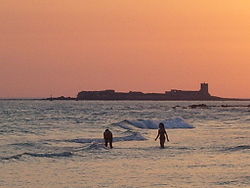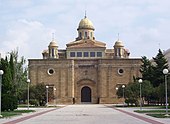world.wikisort.org - Spain
San Fernando (Spanish pronunciation: [ˈsaɱ feɾˈnando], "Saint Ferdinand") is a town in the province of Cádiz, Spain. It is home to more than 97,500 inhabitants. The city also uses the name "La Isla" (The Island). The people from San Fernando are locally known as "Cañaíllas" or "Isleños".
San Fernando | |
|---|---|
Municipality and city | |
 Castle of Sancti Petri | |
 Location of San Fernando within the province of Cadiz | |
 San Fernando Location in Andalusia | |
| Coordinates: 36°28′N 6°12′W | |
| Country | |
| Autonomous community | |
| Province | Cádiz |
| Comarca | Bay of Cádiz |
| Judicial district | San Fernando |
| Commonwealth | Municipes of the Bahía de Cádiz |
| Government | |
| • Alcalde | Patricia Cavada Montañés (PSOE) |
| Area | |
| • Total | 30.65 km2 (11.83 sq mi) |
| Elevation | 8 m (26 ft) |
| Population (2018)[1] | |
| • Total | 95,174 |
| • Density | 3,100/km2 (8,000/sq mi) |
| Demonym | Isleño |
| Time zone | UTC+1 (CET) |
| • Summer (DST) | UTC+2 (CEST) |
| Postal code | 11100 |
| Official language(s) | Spanish |
| Website | Official website |
History
In history, the city played a paramount role when in 1810 during the French occupation led by Napoleon, San Fernando and Cádiz were the only parts of Spain which did not surrender to the French.
The deputies elected to the Cortes of Cádiz met in the Teatro Cómico, and started preparation of the first liberal constitution of Spain, which was approved in the neighbouring city of Cádiz in 1812.
Flamenco singer Camarón de la Isla was born in San Fernando.
It holds the Panteón de Marinos Ilustres.
Notable people from San Fernando
- Julia Medina, singer
- Quintin Dobarganes, Journalist
- Magdalena Álvarez, Politician, former minister of Mr. Zapatero team
- Sara Baras, Flamenco Dancer
- Luis Berenguer, Writer
- Manolo Casal, Canal Sur TV Presenter
- Juan Ruiz Casaux, Cellist and Teacher
- Beato Marcelo Espínola, Bishop, proposed to be a Saint
- Hermana Cristina, Sister, Bishop, proposed to be a Saint
- Camarón de la Isla, Flamenco singer
- Chato de la Isla, Flamenco singer
- Fermín Galán (1899–1930), Spanish soldier who led the failed Jaca uprising a few months before the foundation of the Second Spanish Republic.
- Carmen Guaita, writer[2]
- Anne Hidalgo, incumbent Mayor of Paris
- Francisco José Maldonado, footballer currently with Sporting de Gijón
- Abraham Mateo, Singer and Actor
- Tony Mateo, Singer and Actor
- Fran Ocaña, Singer
- Alex O'Dogherty, Actor
- Pepe Oneto, Journalist
- Rafael Gómez Ortega, Bullfighter
- Niña Pastori, Flamenco singer
- Ana Rosetti, Writer
- Francisco Ruiz Miguel, Bullfighter
- Yordi, retired footballer
- Servando Sánchez, footballer
- David Barral Torres, footballer
- Abraham Mateo, pop singer
- Ramón Rodriguez Verdejo "Monchi", Director of Football of Sevilla F.C.SAD
- José Enrique Varela (1891–1951), military officer
Sister cities
- Montigny-le-Bretonneux,
 France
France - Badalona,
 Spain
Spain - San Fernando Valley,
 United States
United States
Demographics
| Year | Pop. | ±% |
|---|---|---|
| 1999 | 87,179 | — |
| 2000 | 88,179 | +1.1% |
| 2001 | 88,110 | −0.1% |
| 2002 | 88,333 | +0.3% |
| 2003 | 88,490 | +0.2% |
| 2004 | 90,178 | +1.9% |
| 2005 | 92,666 | +2.8% |
| Source: INE (Spain) | ||
 |
 |
See also
- Iglesia Vaticana Castrense de San Francisco
References
- Municipal Register of Spain 2018. National Statistics Institute.
- "Carmen Guaita Fernández | PPC Editorial" (in Spanish). Es.ppc-editorial.com. Archived from the original on 8 October 2019. Retrieved 5 November 2019.
External links
- Cadiz Province – San Fernando
- (in Spanish) Ayuntamiento de San Fernando
- (in Spanish) San Fernando Travel Guide
На других языках
[de] San Fernando (Spanien)
San Fernando ist eine in der Provinz Cádiz in Andalusien gelegene Hafenstadt Südspaniens. Sie befindet sich auf einer von Salzsümpfen umgebenen felsigen Halbinsel, der Isla de León, am Südufer der Bucht von Cádiz. Von den Einheimischen wird die Stadt daher auch einfach „La Isla“ (die Insel) genannt. Sie ist mit der 15 km entfernt liegenden Provinzhauptstadt Cádiz durch eine Landzunge verbunden.- [en] San Fernando, Cádiz
[es] San Fernando (Cádiz)
San Fernando[3][4] —denominada hasta el año 1813 como Villa de la Real Isla de León y llamada coloquialmente como La Isla— es un municipio y ciudad española situada en la provincia de Cádiz, en Andalucía. La localidad pertenece, junto a Cádiz, El Puerto de Santa María, Chiclana de la Frontera, Puerto Real y Rota, a la Mancomunidad de Municipios Bahía de Cádiz.[5] Además, forma parte del área metropolitana de la Bahía de Cádiz-Jerez, aglomeración urbana polinuclear de la que forma parte junto a Cádiz, Jerez de la Frontera, El Puerto de Santa María, Chiclana de la Frontera y Puerto Real, siendo la tercera área metropolitana de Andalucía, por detrás de las de Sevilla y de Málaga, y la duodécima de España.[ru] Сан-Фернандо (Кадис)
Сан-Фернандо (исп. San Fernando) — город и муниципалитет в Испании, входит в провинцию Кадис, в составе автономного сообщества Андалусия. Муниципалитет находится в составе района (комарки) Баия-де-Кадис. Занимает площадь 32 км². Население — 96 689 человек (на 2010 год). Расстояние — 14 км до административного центра провинции.Другой контент может иметь иную лицензию. Перед использованием материалов сайта WikiSort.org внимательно изучите правила лицензирования конкретных элементов наполнения сайта.
WikiSort.org - проект по пересортировке и дополнению контента Википедии

